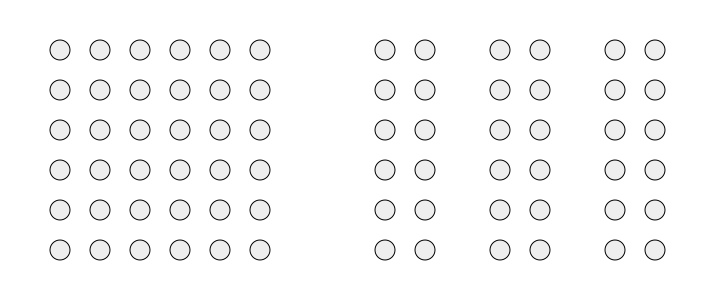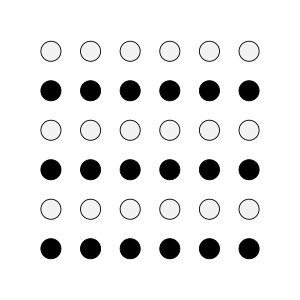Basically Gestalt which is a German word meaning "essence or shape of an entity's complete form" was an idea developed by some German and Austrian Psychologists to help understand how the mind works when presented with certain images set out in a certain way following 6 laws they created. These are as follows-
Law of Proximity- Elements are seen in groupings according to how close they are to each other, what this means is that if you look below at the image on the left you see a square created by individual circles but if you put spaces between the columns the mind interprets it differently and sees instead three columns instead because of the way they are now spaced.

Law of Similarity- elements that are similar in some way, by form or content, tend to be grouped, for example below because the circles are black and white you see three rows of each because this is how the mind interprets the grouping.
 svg">
svg">
 svg">
svg">
Law of Closure- Elements roughly arranged together are seen to complete an outline shape. The mind seeks completeness. With this example below you can still see that the two shapes are a circle and square because your mind recognises what of the shape is present and then fills in the gaps.
 svg">
svg">
Law of Simplicity- simple lines, curves and shapes are preferred to complex ones, basically the mind prefers simple straight forward images, anything with lines, curves running in all directions it finds hard to understand. It would seem a simple is best approach works best.
Law of Common Fate- group elements are assumed to move together and behave as one, if say a herd of animals all seem to be moving in the same direction the brain interprets them all as belonging to the same group because of this group movement.
Law of Good Continuation- the mind's eye likes to continue shapes and lines beyond their ending points, when they disappear out of the frame the mind understands that they continue/carry on in the case of shapes.
So now I've explain what the Gestalt Laws are its time to try to understand how these can be used as an advantage within Photography. The first thing to consider is that Gestalt is sometime described as "the whole is greater than the sum of the parts" in photography terms to me this says that when you look at a photo you have to take in the whole scene to understand the subject, but then as the photographer you have to be far more considered when framing a subject because you're looking to capture an image with many layers of meaning in that you have your subject but you also need the surrounding area/background to have some relationship to it so as to add to the shot in some way. Another way to look at it is that lets be honest we live in a very chaotic world and sometimes the thing we shot can appear equally so but by using some of the laws set out above we can bring a little calm back and let our inner eye more easily understand and interpret what we've captured.
I know its more psychology then photography but when you study other peoples work with these laws in mind you can see how they work and improve the feel of an image straight away, some of these thing I've already been doing subconsciously because i know what looks and feel right but now actually knowing why i frame a subject in a certain way or group a particular group of focus points together kind of adds a deeper understanding to my work that i was clear lacking before hand.
Found good website with more explanation on Gestalt at- www.users.totalise.co.uk/~kbrown/lectures/gestalt.htm
(All images taken from Wikipedia page http://en.wikipedia.org/wiki/Gestalt_psychology)
No comments:
Post a Comment